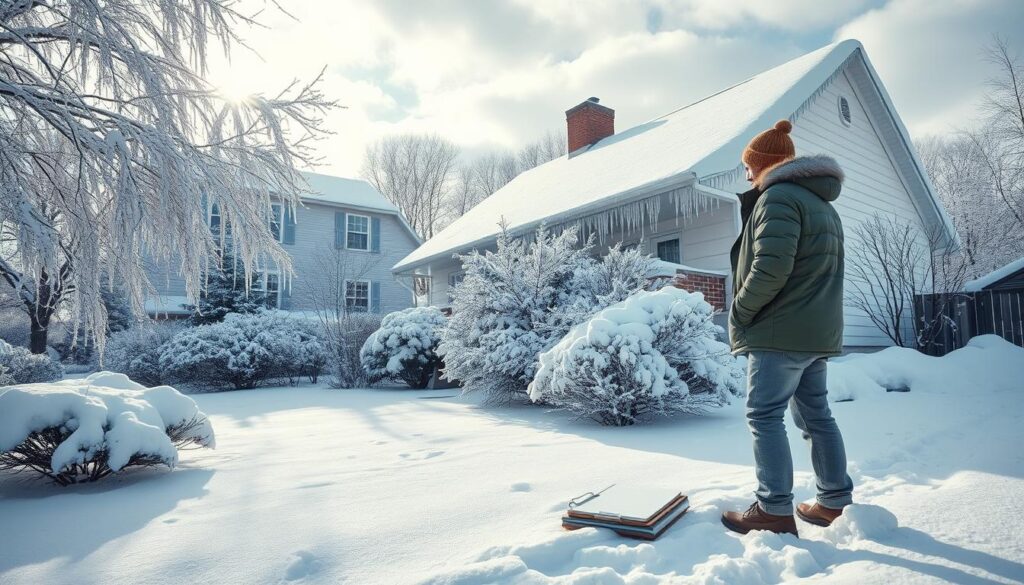As the seasons change, the real estate market offers unique winter opportunities. Investing in real estate during winter can help you grow your wealth. Knowing the seasonal trends is crucial for smart decisions.
Winter real estate investments can be very profitable. Being aware of current trends helps you maximize your investment. With the right strategy, you can benefit from winter investing.
We’ll cover everything you need to know for winter real estate success. This includes understanding market dynamics and building a winter-ready portfolio. We’ll help you take advantage of seasonal trends.
Key Takeaways
- Winter real estate investment opportunities can be lucrative
- Understanding seasonal real estate trends is key to making informed decisions
- Investing in real estate during the winter months can be a great way to unlock wealth
- Capitalizing on winter real estate investment opportunities requires the right knowledge and strategy
- Building a winter-ready investment portfolio is crucial for long-term success
Understanding Winter Real Estate Investment Opportunities
Winter property investment requires a deep understanding of the market. The cold-weather real estate market has its own set of opportunities and challenges. Investors must analyze seasonal price changes and how buyers and sellers act.
The winter months often see a slower real estate market. But this slowdown can lead to lower prices and less competition. Seasonal price fluctuations are big, with prices dropping in winter and rising in spring and summer. Knowing these changes helps investors decide the best times to buy and sell.
Market Dynamics During Winter Months
The winter real estate market has lower demand and prices. But, this also means investors can negotiate better deals. Key factors to consider in winter property investment include:
- Lower demand and lower prices
- Less competition from other buyers
- More negotiating power for investors
Seasonal Price Fluctuations
Seasonal price changes are crucial for winter property investment. By understanding these changes, investors can make smart decisions about buying and selling. Important factors to consider include:
| Season | Price Trend |
|---|---|
| Winter | Lower prices |
| Spring | Rising prices |
| Summer | Higher prices |
| Fall | Falling prices |
Buyer-Seller Psychology in Winter Markets
Buyer-seller psychology is also key in winter property investment. Knowing what drives buyers and sellers helps investors make better decisions and negotiate better deals.
Why Winter Creates Unique Investment Advantages
Winter is a special time for investors to find great deals in the real estate market analysis. With fewer buyers around, you can get better prices and find hidden gems. This is especially true for those who use winter real estate investment strategies to find sellers who really need to sell.
Some of the key benefits of winter real estate investing include:
- Lower prices due to reduced demand
- Less competition from other buyers
- Motivated sellers who are more willing to negotiate
By understanding the real estate market analysis and using smart winter real estate investment strategies, investors can thrive in the winter. It’s crucial to stay updated and adjust to the market’s changes.
Winter brings unique investment chances that can help you reach your goals. By being well-informed and strategic, you can seize the opportunities in the winter real estate market. This way, you can maximize your investments.
| Season | Market Conditions | Investment Opportunities |
|---|---|---|
| Winter | Lower demand, motivated sellers | Undervalued properties, negotiated deals |
Strategic Property Types for Winter Investment
Understanding the best property types for winter investing is key to success. Knowing the pros and cons of each helps investors make smart choices. This way, they can build a diverse portfolio that fits seasonal trends. It also helps them take advantage of winter opportunities, adding to their investment diversity.
Some top property types for winter include:
- Vacation rentals and holiday homes, which can make a lot of money in winter
- Multi-family properties, providing steady income from rentals
- Commercial real estate, like retail or office spaces, which see more visitors in winter
Investing in these types helps people manage seasonal trends well. It boosts their portfolio diversity and growth chances.
Exploring these options, it’s vital to know each property’s unique traits and challenges. This ensures their investment plan is well-thought-out and meets their goals.
Analyzing Winter Market Conditions
To do well in the winter real estate market, you need to do a deep dive into the investment analysis. Look at things like how much is available, how much people want, interest rates, and the economy. Keeping up with market trends helps you make better choices and adjust your plans.
When looking at winter market conditions, consider a few important things:
- Seasonal changes in demand
- How interest rates affect mortgage costs
- Key economic signs like GDP and job rates
Knowing these can help you move through the winter market smartly. Real estate investment analysis is key to spotting chances and dangers. It’s vital for both new and experienced investors to stay informed and adjust to market shifts.
In the winter market, there are special challenges and chances. A detailed investment analysis and keeping current with trends are crucial. They help you make smart moves and succeed in your winter real estate ventures.
Financial Considerations for Cold-Weather Properties
Investing in cold-weather properties needs careful thought about money matters. Managing a property in the cold has its own set of challenges. You must think about the costs of winter maintenance, like snow removal and heating upkeep.
Insurance is also a big deal. Properties in cold areas might need special insurance to cover damage from snow and ice. When it comes to financing, the location and condition of the property matter a lot. It’s essential to work with a lender who understands the unique challenges of cold-weather properties to get the best deals.
Some key financial things to think about for cold-weather properties include:
- Winter maintenance costs, such as snow removal and heating system maintenance
- Insurance requirements, including specialized policies for cold-weather damage
- Seasonal cash flow patterns, which can be affected by factors such as rental income and maintenance expenses
Understanding these financial points can help you manage your investment better. It’s important to have a team of experts, like a lender, insurance agent, and property manager. They can help you make smart choices about your cold-weather property.
| Financial Consideration | Description |
|---|---|
| Winter Maintenance Costs | Expenses such as snow removal, heating system maintenance, and pipe insulation |
| Insurance Requirements | Specialized policies to protect against damage from snow, ice, and freezing temperatures |
| Seasonal Cash Flow Patterns | Factors such as rental income and maintenance expenses that affect cash flow |
Due Diligence in Winter Property Assessment
When buying a property in winter, it’s crucial to do your homework. This means checking the property’s condition and emergency plans. This way, you can avoid problems and make a smart investment.
Checking the property’s condition is a big part of due diligence. Look at the roof, walls, and foundation. Also, check the plumbing, electrical, and heating systems. Infrastructure evaluation helps ensure the property can handle winter.
Emergency planning is also key. Have a plan for things like power outages and snowstorms. This helps protect the property and keeps people safe. Here’s what to include in your inspection checklist:
- Roof condition and insulation
- Wall and foundation integrity
- Plumbing and electrical system evaluation
- Heating system inspection
- Emergency preparedness planning
By using this checklist, you can make sure your winter property is a good investment. Remember, doing your due diligence is important for making smart choices and avoiding problems. 
| Category | Inspection Items |
|---|---|
| Exterior | Roof condition, wall integrity, foundation condition |
| Interior | Plumbing, electrical, heating system inspection |
| Emergency Preparedness | Plan for power outages, frozen pipes, snowstorms |
Negotiation Strategies for Winter Purchases
When it comes to winter real estate negotiation, being prepared is key. Knowing the market and working with sellers who want to sell can help you get good deals. Winter is a great time to buy investment property because sellers are often more willing to sell.
To successfully negotiate a winter real estate purchase, consider the following strategies:
- Research the market to determine fair prices
- Work with a real estate agent who has experience in winter sales
- Be prepared to act quickly when finding a suitable property
By mastering these negotiation strategies, you can achieve your investment goals and build wealth in the real estate market. Remember to stay focused on your goals and be flexible during the negotiation process.
With the right approach, winter real estate negotiation can be a successful and profitable experience. This is especially true when combined with effective investment property purchasing strategies.
| Strategy | Description |
|---|---|
| Market Research | Researching the market to determine fair prices and understand the competition |
| Experienced Agent | Working with a real estate agent who has experience in winter sales to get expert guidance |
| Quick Action | Being prepared to act quickly when finding a suitable property to secure the deal |
Building a Winter-Ready Investment Portfolio
Creating a strong investment portfolio needs careful planning. You must think about diversification, risk management, and growth over time. For a winter real estate portfolio, these are even more important. A good portfolio spreads investments across different types to lower risk and increase returns.
A diverse winter real estate portfolio might include homes for rent and commercial properties. This mix helps you avoid big losses and aims for steady growth. It’s key to manage risks by researching the market and looking at financial data.
Some important steps for a winter-ready portfolio are:
- Do deep market research to spot trends and chances
- Spread your investments across different types and properties
- Plan for long-term growth, considering seasonal changes and trends

By using these strategies and keeping up with market trends, you can build a solid winter real estate portfolio. This portfolio will likely bring in good returns and help you reach your financial goals. Managing your portfolio well is key to success in the winter real estate market.
| Investment Strategy | Risk Level | Potential Return |
|---|---|---|
| Diversification | Low | Steady growth |
| Long-term growth planning | Medium | Higher returns |
| Risk management | Low | Capital preservation |
Conclusion: Maximizing Your Winter Real Estate Investment Success
Winter real estate investing offers many chances for smart investors. Knowing about seasonal price changes and how buyers and sellers act is key. This knowledge helps you succeed and grow your wealth over time.
To do well in winter real estate, you need a solid plan. This includes studying the market, planning your finances, and doing your homework. These steps help you handle the challenges of winter properties and find their benefits.
Having a mix of winter-ready properties is crucial. It helps you reach your financial goals. By spreading out your investments, managing risks, and planning for the future, you’re ready for the seasonal market. This way, you can build a strong financial future.
Winter real estate investing is full of chances. Let your love for smart investing lead you to success. With the right attitude, knowledge, and actions, you can make the most of this market. You’ll create a real estate investment strategies that last.

